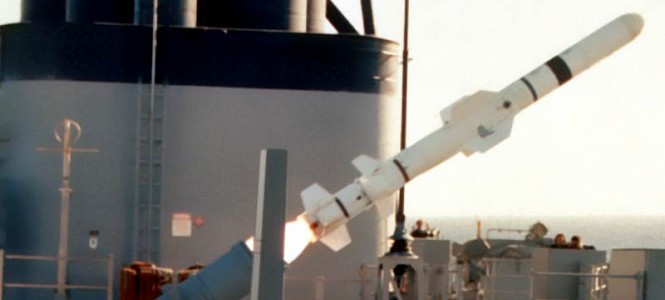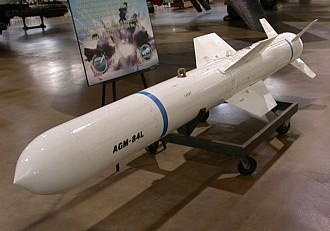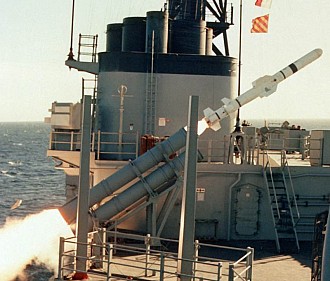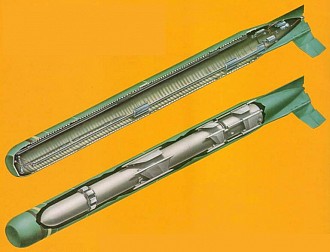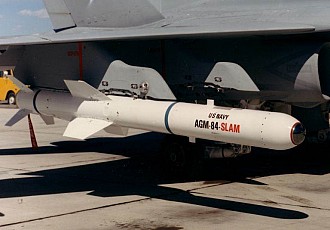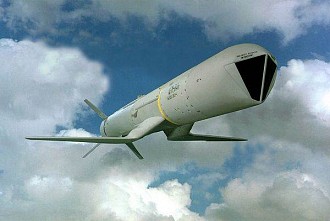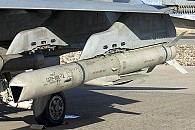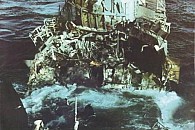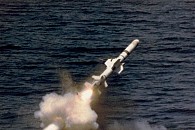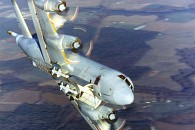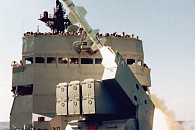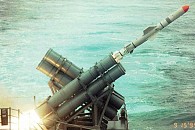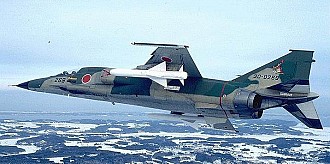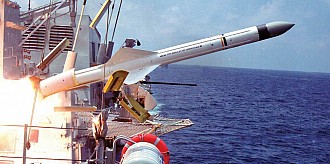Munitions / Surface to surface missiles / Harpoon
Harpoon
General Facts
- TYPE
Anti-ship missile - ORIGIN
 United States
United States - NICKNAMES
GWS-60 (UK designation for UGM-84B) - DESIGNED
1968 - 1974 - DESIGNER
McDonnell Douglas - PRODUCTION
1975 - present - PRODUCERS
 United States - McDonnell Douglas (now part of Boeing)
United States - McDonnell Douglas (now part of Boeing) - QUANTITY
Over 7.000 Harpoon
Over 1.000 SLAM - UNIT COST
$ 1.2 million for Block 2 in 2009 - CHARACTERISTICS
 Limited production costs
Limited production costs
 Wide variety of launch platforms
Wide variety of launch platforms
 Subsonic
Subsonic
 Average range at current standards
Average range at current standards
Introduction
The Harpoon is an anti-ship missile of US origin. It was developed in the early 1970's as armament for aircraft, but by adding a booster section it eventually became more prominent as a surface to surface missile for ships and submarines. The Harpoon can be considered the main anti-shipping missile of the Western nations, even though Exocet, Otomat and RBS-15 are widely used as well. The Harpoon is the main anti-ship armament of many NATO frigates and destroyers.
Layout
The Harpoon has a long cylindrical body and a pointed nose. In the middle there are four cruciform wings and four smaller control fins are located at the rear. The first quarter of the missile is the guidance section including radar, inertial navigation and associated electronics. The second quarter is the high explosive warhead which is to penetrate the hull and detonate inside the target vessel. The second half of the missile is the solid fuel sustainer rocket motor. In the surface launched models an additional solid fuel booster section is added at the rear which burns for about 3 seconds and provides initial velocity.
Guidance
The Harpoon uses active radar homing to detect and track enemy vessels. Inertial navigation is used until the missile reaches the target area. Over time the guidance has been improved by adding a re-attack capability, GPS aided inertial navigation and a two way data link in the latest versions. The Harpoon also possesses a very limited land attack capability. The SLAM land attack derivatives use imaging infrared guidance combined with a data link. Over its lifetime the Harpoon has proven to have a success rate of over 90 percent.
Firepower
The Harpoon is a subsonic anti-ship missile that travels at Mach 0.9. Early models performed a pop up attack but subsequent versions are sea skimming missiles. The 220 kg warhead will destroy most frigates and destroyers. Larger vessels may require multiple hits. The effective range for most models is 130 km. Due the inherent air speed and gravity induced velocity the air launched models have a much longer effective range. The SLAM-ER
Platform
The air launched Harpoons are carried on external stores mounts of fixed wing aircraft. Aircraft that may launch the Harpoon include the P-3 Orion, S-3 Viking, F-16 Fighting Falcon, F/A-18 Hornet and the B-52 Stratofortress. On ships the quad pack Mk 141 launcher is the most common launcher. Usually a pair of Mk 141 launchers is used with one facing port and the other starboard. The Mk 112 ASROC launcher, Mk 13 and Mk 22 single arm launchers and Mk 11 twin arm launcher are used as well. The submarine launched models are fitted in a capsule with the size of a 533mm torpedo and is launched from the torpedo tubes. A small number of Harpoons is in use on coastal defense systems.
Users
The main user of the Harpoon is the US Navy which uses all types including the SLAM models. Many Harpoon missiles are in use with NATO nations and other US allies. Production for the United States has ceased although upgrades programs are still continuing. The production for export continues and the SLAM-ER remains in production as well.
AGM-84 Harpoon
The air launched versions of the Harpoon all have the designation AGM-84. The Harpoon can be carried by a wide range of fixed wing aircraft ranging from low speed maritime patrol aircraft such as the P-3 Orion to supersonic fighter aircraft like the F/A-18 Hornet. Unlike the surface vessel and submarine launched versions the air launched versions are not fitted with a booster section. A booster isn't required due to the air speed during release and gravity . Over time the capabilities have been improved which results in wide range of models.
AGM-84A: Original air launched version of the Harpoon.
AGM-84C: Harpoon Block 1B upgrade introduced in 1982 that replaces the pop up flight profile with a sea skimming one.
AGM-84D: Harpoon Block 1C upgrade introduced in 1985 with increased range, selectable pop up or sea skimming mode, ECCM improvements and plottable waypoints.
AGM-84F: Harpoon Block 1D upgrade introduced in 1991 with more fuel resulting in longer body and increased range. Also as a re-attack capability. Few produced since program was cancelled in 1993.
AGM-84G: Harpoon Block 1E conversion of Block 1C with improved ECCM capabilities and Block 1D re-attack capability.
AGM-84L: Harpoon Block 2 upgrade of Block 1E with GPS aided inertial navigation and improved hardware.
AGM-84M: Harpoon Block 3 upgrade with GPS aided inertial navigation and two way data link.
- Specifications:
- AGM-84A Harpoon
- AGM-84D Harpoon
- AGM-84F Harpoon
| Type | Anti-ship missile |
|---|---|
| Diameter | 0.343 m body, 0.9 m wingspan |
| Length | 3.85 m |
| Weight | 519 kg |
| Guidance | Active radar homing |
|---|---|
| Warhead | 221 kg WDU-18/B penetrating HE-frag |
| Propulsion | Teledyne J402-CA-400 turbojet |
| Speed | Mach 0.9 |
| Range | 185 km |
|---|---|
| Altitude | - |
| Engagement envelope | - |
| Remarks | - |
| Type | Anti-ship missile |
|---|---|
| Diameter | 0.343 m body, 0.9 m wingspan |
| Length | 3.85 m |
| Weight | 540 kg |
| Guidance | Active radar homing |
|---|---|
| Warhead | 221 kg WDU-18/B penetrating HE-frag |
| Propulsion | Teledyne J402-CA-400 turbojet |
| Speed | Mach 0.9 |
| Range | 220 km |
|---|---|
| Altitude | - |
| Engagement envelope | - |
| Remarks | - |
| Type | Anti-ship missile |
|---|---|
| Diameter | 0.343 m body, 0.9 m wingspan |
| Length | 4.44 m |
| Weight | 635 kg |
| Guidance | Active radar homing |
|---|---|
| Warhead | 221 kg WDU-18/B penetrating HE-frag |
| Propulsion | Teledyne J402-CA-400 turbojet |
| Speed | Mach 0.9 |
| Range | 315 km |
|---|---|
| Altitude | - |
| Engagement envelope | - |
| Remarks | - |
RGM-84 Harpoon
The surface launched versions of the Harpoon are designated RGM-84. They are mainly launched from surface vessesl although a few coastal defense systems are in use as well. Apart from adding a booster section which increases initial velocity during launch the surface launched versions of the Harpoon are similar to the air launched versions.
RGM-84A: Original surface vessel launched version of the Harpoon.
RGM-84C: Harpoon Block 1B upgrade introduced in 1982 that replaces the pop up flight profile with a sea skimming one.
RGM-84D: Harpoon Block 1C upgrade introduced in 1985 with increased range, selectable pop up or sea skimming mode, ECCM improvements and plottable waypoints.
RGM-84F: Harpoon Block 1D upgrade introduced in 1991 with more fuel resulting in longer body and increased range. Also as a re-attack capability. Few produced since programme was cancelled in 1993.
RGM-84G: Harpoon Block 1E conversion of Block 1C with improved ECCM capabilities and Block 1D re-attack capability.
RGM-84L: Harpoon Block 2 upgrade of Block 1E with GPS aided inertial navigation and improved hardware.
RGM-84M: Harpoon Block 3 upgrade with GPS aided inertial navigation and two way data link.
- Specifications:
- RGM-84A Harpoon
- RGM-84D Harpoon
- RGM-84F Harpoon
| Type | Anti-ship missile |
|---|---|
| Diameter | 0.343 m body, 0.9 m wingspan |
| Length | 4.63 m |
| Weight | 682 kg |
| Guidance | Active radar homing |
|---|---|
| Warhead | 221 kg WDU-18/B penetrating HE-frag |
| Propulsion | Teledyne J402-CA-400 turbojet plus solid fuel rocket booster |
| Speed | Mach 0.9 |
| Range | 130 km |
|---|---|
| Altitude | - |
| Engagement envelope | - |
| Remarks | - |
| Type | Anti-ship missile |
|---|---|
| Diameter | 0.343 m body, 0.9 m wingspan |
| Length | 4.63 m |
| Weight | 690 kg |
| Guidance | Active radar homing |
|---|---|
| Warhead | 221 kg WDU-18/B penetrating HE-frag |
| Propulsion | Teledyne J402-CA-400 turbojet plus solid fuel rocket booster |
| Speed | Mach 0.9 |
| Range | 150 km |
|---|---|
| Altitude | - |
| Engagement envelope | - |
| Remarks | - |
| Type | Anti-ship missile |
|---|---|
| Diameter | 0.343 m body, 0.9 m wingspan |
| Length | 5.28 m |
| Weight | 785 kg |
| Guidance | Active radar homing |
|---|---|
| Warhead | 221 kg WDU-18/B penetrating HE-frag |
| Propulsion | Teledyne J402-CA-400 turbojet plus solid fuel rocket booster |
| Speed | Mach 0.9 |
| Range | 220 km |
|---|---|
| Altitude | - |
| Engagement envelope | - |
| Remarks | - |
UGM-84 Sub Harpoon
Unlike most anti ship missiles the Harpoon can also be launched from submarines. These models are designated UGM-84. They are launched from a 533mm torpedo tube and float to the surface in a special canister. Once the canister breaks the surface the top cover is removed and the booster section that is also used on the surface launched model is fired. Many surface launched models have a submarine launched counterpart.
UGM-84A: Original submarine launched version of the Harpoon.
UGM-84B: UK version with lower attack profile.
UGM-84C: Harpoon Block 1B upgrade introduced in 1982 that replaces the pop up flight profile with a sea skimming one.
UGM-84D: Harpoon Block 1C upgrade introduced in 1985 with increased range, selectable pop up or sea skimming mode, ECCM improvements and plottable waypoints.
UGM-84G: Harpoon Block 1E conversion of Block 1C with improved ECCM capabilities and Block 1D re-attack capability.
AGM-84 SLAM
The SLAM is a land attack version of the Harpoon missile introduced in 1988. The name SLAM stands for Stand-off Land Attack Missile. The SLAM is a Harpoon with a imaging infrared guidance section used on the AGM-65D Maverick and the data link of the AGM-62 Walleye. The SLAM flies inertially to its target and is manually controlled for the last 60 seconds.
AGM-84E SLAM: The SLAM version of the Harpoon only exist in air launched form and is also known as the Harpoon Block 1E.
- Specifications:
- AGM-84E SLAM
| Type | Air to ground missile |
|---|---|
| Diameter | 0.343 m body, 0.9 m wingspan |
| Length | 4.50 m |
| Weight | 627 kg |
| Guidance | Inertial guidance towards target area, imaging infrared terminal mode |
|---|---|
| Warhead | 221 kg WDU-18/B penetrating HE-frag |
| Propulsion | Teledyne J402-CA-400 turbojet |
| Speed | Mach 0.9 |
| Range | 93 km |
|---|---|
| Altitude | - |
| Engagement envelope | - |
| Remarks | - |
AGM-84 SLAM-ER
The SLAM Expanded Response is a much improved version of the original SLAM. It uses pop-out wings for increased range and maneuvrability, has a better data link, has a larger warhead and uses a new guidance section. The guidance section adds GPS guidance over the inertial guidance and the
AGM-84H SLAM-ER: Original version of the SLAM-ER.
AGM-84K SLAM-ER: SLAM-ER with internal improvements.
- Specifications:
- AGM-84H SLAM-ER
| Type | Air to ground missile |
|---|---|
| Diameter | 0.343 m body, 2.43 m wingspan |
| Length | 4.37 m |
| Weight | 725 kg |
| Guidance | GPS assisted inertial guidance towards target area, imaging infrared terminal mode |
|---|---|
| Warhead | 360 kg WDU-40/B penetrating HE-frag |
| Propulsion | Teledyne J402-CA-400 turbojet |
| Speed | Mach 0.9 |
| Range | 280 km |
|---|---|
| Altitude | - |
| Engagement envelope | - |
| Remarks | - |

